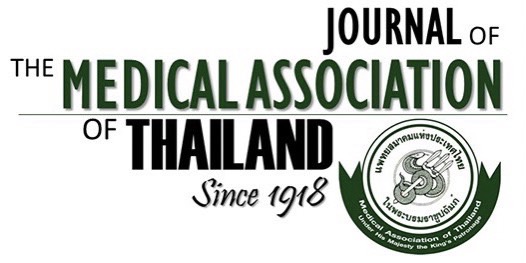Efficacy of Venous Thromboembolism Prophylaxis in Patients Undergoing Pelvic Cancer Surgery: A Randomized Controlled Trial
Piyanut Pootracool MD*, Kanoklada Srikuea MD*, Wiwat Tirapanich MD*, Sopon Jirasiritum MD*, Surasak Leela-Udomlipi MD*, Suthas Horsirimanont MD*, Nutsiri Kittitirapong MD*, Wisoot Kongchareonsombat MD**, Sarikapan Wilailak MD***
Affiliation : * Division of Vascular Surgery, Department of Surgery, Faculty of Medicine Ramathibodi Hospital, Mahidol University, Bangkok, Thailand ** Division of Urological Surgery, Department of Surgery, Faculty of Medicine Ramathibodi Hospital, Mahidol University, Bangkok, Thailand *** Department of Gynecologic Oncology, Faculty of Medicine Ramathibodi Hospital, Mahidol University, Bangkok, Thailand
Backgrounds: Pelvic cancer surgery has a high risk for venous thromboembolism (VTE). Pharmacologic venous
thromboprophylaxis is not routinely accepted among surgical practice in Thailand due to the awareness of major bleeding
complication. However, ACCP guideline recommends mechanical prophylaxis to be initially used in this condition and
pharmacologic prophylaxis is subsequently administered during postoperative period with minimal risk of bleeding. Therefore,
it was possible to evaluate the efficacy of VTE prophylaxis in pelvic cancer surgery among our population.
Objective : To evaluate the efficacy and safety of VTE prophylaxis in pelvic cancer surgery.
Material and Method: Patients with pelvic cancer including gynecologic cancer and urologic cancer to undergo surgery
were enrolled in the present study. The patients with colorectal cancer were excluded from the present study due to their
declination. The present study randomized the patients into 2 groups regarding the receiving VTE prophylaxis. In prophylaxis
group, intermittent pneumatic compression (IPC) was initially applied at intraoperative period and at least 3 days
postoperatively until full ambulation. During the minimal risk of postoperative bleeding in this group, Enoxaparin (0.4 ml
subcutaneous daily) was administered for 4 weeks. In control group, there was no VTE prophylaxis. Assessment of VTE was
carried out at the 2nd and 5th week after surgery. Postoperatively, diagnosis of deep vein thrombosis (DVT) was performed by
duplex ultrasonography and diagnosis of pulmonary embolism (PE) was initially done by clinical manifestations and then
confirmed by computed tomographic angiography of pulmonary artery.
Results : A total of 108 pelvic cancer patients including 70 patients with gynecologic cancer and 38 patients with urologic
cancer. The prevalence of proximal DVT after pelvic cancer surgery in the present study was 2.8%, which were 3.7% in
control group and 1.8% in prophylaxis group (p = 1.000). The relative risk reduction was 50%. In gynecologic cancer
patients, prevalence of postoperative proximal DVT was 6.5% in control group and 2.6% in prophylaxis group (p = 0.580).
The relative risk reduction was 60%. There was no postoperative proximal DVT in urologic patients. Postoperative
symptomatic PE was not found in this study. Bleeding complications was 3.7% (1.8% major bleeding and 1.8% minor
bleeding) in prophylaxis group compared with 0% in control group (p = 0.495).
Conclusion : After the implementation of VTE prophylaxis in pelvic cancer surgery, the prevalence of postoperative proximal
DVT was decreased with significant risk reduction in gynecologic cancer surgery and the risk of postoperative bleeding was
acceptable. VTE prophylaxis program may be benefit in gynecologic cancer surgery in Thai population.
Keywords : Venous thromboembolism, cancer surgery, DVT prophylaxis, VTE prophylaxis, deep vein thrombosis, pulmonary embolism



